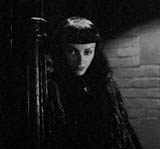Dark
Energy
(page 3)
the thing itself
There you have the basic components. What's the thing itself?
The void:
 The
thing itself is
a story about people trying to make their way in an environment that
is at best indifferent, at worst overtly hostile, but in all cases
inexplicable.
This may seem a narrow channel through which to run 800 movies,
but they come from everywhere. Point-of-view can be the naturalism
of The
Wages of Fear* or
the surrealism of Blue Velvet*.
It can be epic, as in The
Leopard*, or
claustrophobic, as in Repulsion*.
It can even be both at once, as in Underground*.
Noir tends to be local, and gothic tends to be cosmic; but in either
case,
the
central action is enmeshed in a web that recedes to a void.
The
thing itself is
a story about people trying to make their way in an environment that
is at best indifferent, at worst overtly hostile, but in all cases
inexplicable.
This may seem a narrow channel through which to run 800 movies,
but they come from everywhere. Point-of-view can be the naturalism
of The
Wages of Fear* or
the surrealism of Blue Velvet*.
It can be epic, as in The
Leopard*, or
claustrophobic, as in Repulsion*.
It can even be both at once, as in Underground*.
Noir tends to be local, and gothic tends to be cosmic; but in either
case,
the
central action is enmeshed in a web that recedes to a void.
The tone is generally introverted. That's why The Leopard is here but Lawrence of Arabia is not. It's a little more complicated explaining why Pet Sematary is included while Night of the Living Dead is not. In the latter the threat comes from out there somewhere, maybe having to do with funky radiation. In the former, the dead also rise, but it seems to have more to do with recycled family karma and is more introverted in theme if not in execution: our own psychological weirdness goes to the grave, does a u-turn, and comes back at us. Delicious "B" feel to that one, by the way. Lewton, though, would have been appalled at the explicit violence. He was of the opinion that what's not visible is more frightening than what is.
Extrovert/introvert:
 This
business of an outside threat as opposed to an inside threat is why
Frankenstein's monster and Dracula are
not here*, though
three of their most celebrated directors (Tod Browning, James Whale,
Terence
Fisher) do show up with other titles. Satan makes an appearance now
and again - Rosemary's Baby*, The
Devil Rides Out*, Angel
Heart*, Bedazzled* -
but this is because he seems to be the embodiment of mental constructs
such as fear, greed, and guilt rather than a bloodthirsty beast along
the lines of a
werewolf.
This
business of an outside threat as opposed to an inside threat is why
Frankenstein's monster and Dracula are
not here*, though
three of their most celebrated directors (Tod Browning, James Whale,
Terence
Fisher) do show up with other titles. Satan makes an appearance now
and again - Rosemary's Baby*, The
Devil Rides Out*, Angel
Heart*, Bedazzled* -
but this is because he seems to be the embodiment of mental constructs
such as fear, greed, and guilt rather than a bloodthirsty beast along
the lines of a
werewolf.
The extrovert/introvert dichotomy also explains why Bogart is in eleven of these movies and Cagney in only two*. Not that James is all that introverted in White Heat*, but his doom-laden Freudian neuroses in this outing put just the right shadows on what might, in fact, be his most type-A performance ever.
Jack Palance, who exemplifies Dark Energy as well as any single actor could, appears four times. Whether he should be considered an extrovert or an introvert is pretty much up for grabs.
By way of contrast, let me introduce you to British actor Dennis Price, also an exemplar of Dark Energy. He was once described by director Michael Powell as "impudently well-mannered," a very different shade of dark from Palance.
Anyway, the thing itself looks a bit like this.
| p.1:
intro p.2: components p.4: observations |
